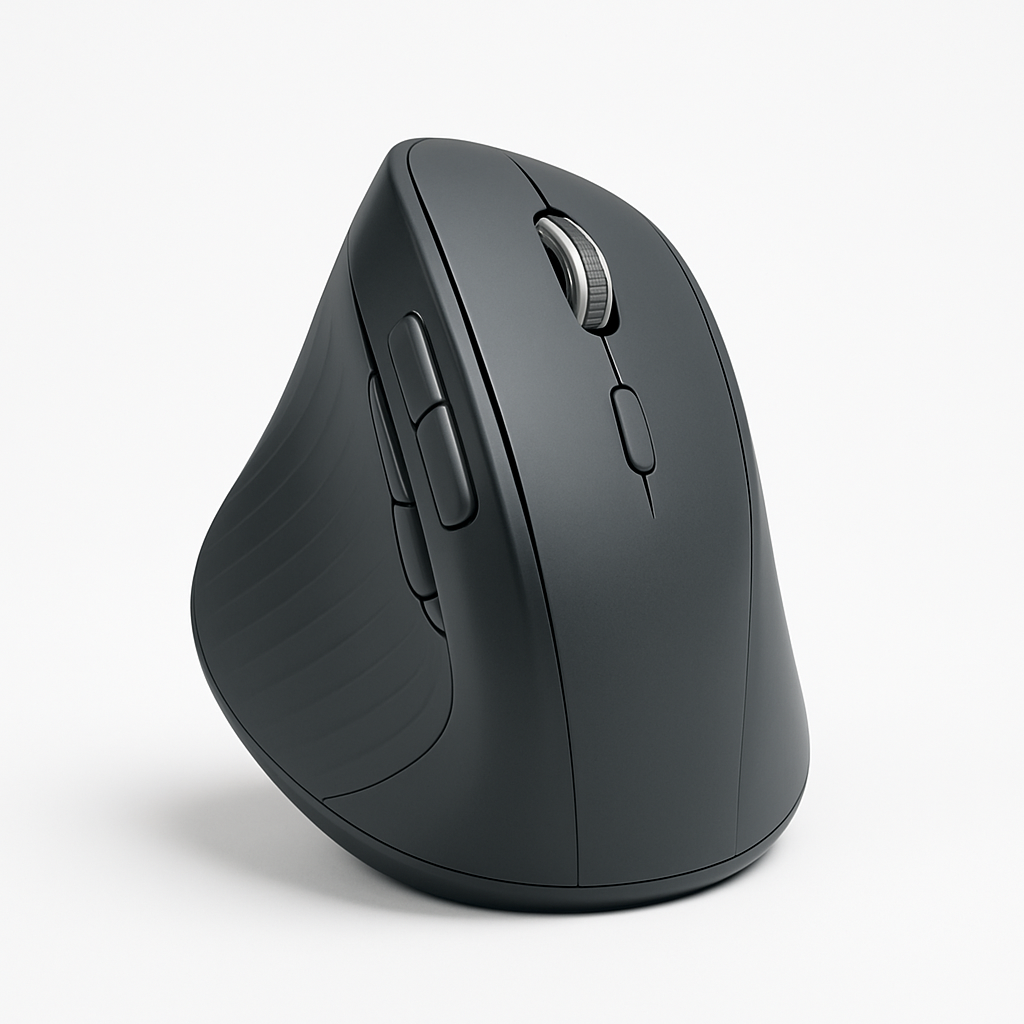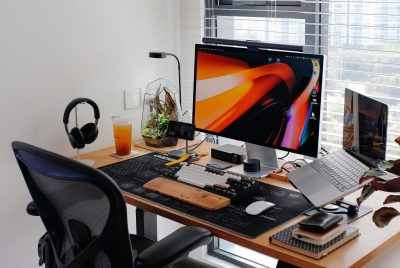5 Ergonomic Mouse Designs | 2026 Edition
We may earn a commission for purchases made using our links. Please see our disclosure to learn more.
Finding the right ergonomic mouse can make your workday much more comfortable. If your wrist aches or your fingers feel tight after long hours at the computer, your mouse may be the real cause. A standard mouse forces your hand into an awkward position, and that strain builds up fast. Over time, it can affect your comfort, focus, and productivity.
An ergonomic design fixes this by supporting your hand in a more natural posture. It reduces pressure on your wrist and helps your arm move in a healthier way. The result is less pain and smoother work.
In this article, you’ll discover the top mouse designs for 2026, what makes them stand out, and how to choose the right one for your setup. Let’s get started.
Why Your Mouse Might Be Causing You Pain
We rarely think about how much strain a simple mouse can create. A traditional, flat mouse forces you to twist your forearm inward—what experts call pronation. At first, your body tolerates it. Hours pass. Days pass. Eventually, that tension collects in your forearm, wrist, and fingers. If you’ve ever felt tingling or tightness after a long workday, you’ve experienced this firsthand.
The problem really shows up when your workload grows. Every scroll, click, drag, or rapid movement adds micro-stress. Even small misalignments compound into fatigue and pain. Office workers, students, digital creatives, gamers, and remote employees all face the same risks because the motion is repetitive and constant.
Ergonomic mice shift this dynamic. Instead of forcing your hand into a position that works against your natural posture, they let your hand sit in a relaxed, neutral angle. That simple change can reduce muscle tension, lower wrist strain, and support healthier movement patterns throughout the day.

What to Look for in an Ergonomic Mouse
Choosing the right ergonomic mouse isn’t about picking the most expensive option or the coolest-looking gadget. It’s about picking something that supports your natural biomechanics. Here’s what matters most:
1. Shape and Grip
This determines how your wrist, fingers, and forearm align. Vertical mice keep the forearm in a handshake position, reducing pronation. Sculpted horizontal mice offer curved surfaces that support the palm while reducing pressure points.
2. DPI and Tracking
DPI (dots per inch) controls cursor sensitivity. Higher DPI means your cursor moves further with smaller hand motions—great for larger screens or multi-monitor setups. Many ergonomic mice allow DPI adjustments for precise, customized control.
3. Buttons and Customization
Extra buttons aren’t just for gamers. They make everyday tasks easier—copying, pasting, navigating, switching apps, or scrolling through documents. Setting up your own shortcut buttons helps you work faster and lowers repeated hand movements.
4. Wireless vs. Wired
Wireless mice keep your desk clean and reduce tugging tension on your wrist. Wired options offer consistent performance and zero battery management. Both work well; it’s about your personal workflow.
5. Vertical vs. Horizontal
Vertical models minimize wrist rotation. Horizontal ergonomic mice feel familiar but still add support and curvature. Some users transition instantly to vertical designs, while others prefer a sculpted horizontal layout.
With those basics in mind, let’s explore the top ergonomic mouse designs worth upgrading to in 2026.

Best Ergonomic Mouse Designs for 2026
After evaluating user reviews, performance data, scientific research, and real-world comfort tests, these five ergonomic mice stand out as the best options for the coming year.
1. Logitech MX Vertical Advanced Ergonomic Mouse
The MX Vertical remains one of the strongest contenders for anyone who spends serious time on a computer. Its natural 57-degree angle encourages a handshake posture, reducing muscular strain almost instantly. The textured grip and supportive thumb rest keep your hand centered and stable.
Logitech also integrates precise cursor tracking with adjustable DPI, allowing you to move a cursor across a large monitor with minimal hand movement. Its software lets you customize buttons and flow seamlessly between multiple devices.
Best for: Office professionals, remote workers, creatives
Why it’s great: Scientifically designed to reduce muscle activity by up to 10%
2. Anker Wireless Vertical Ergonomic Mouse
If you want a wallet-friendly ergonomic mouse without sacrificing comfort, the Anker Vertical delivers impressive value. It doesn’t have the advanced customization of pricier models, but the upright handshake position provides immediate wrist relief.
Its lightweight build makes it ideal for daily use, and the plug-and-play setup works for practically any device. For users curious about ergonomic setups but unsure where to start, this is an excellent entry point.
Best for: Budget-conscious users
Why it’s great: Simple, reliable, comfortable, and easy to adapt to
3. Logitech MX Master 3S
Not everyone loves vertical mice, and that’s okay. The MX Master 3S offers a sculpted, curved horizontal design that supports the natural curve of your hand while reducing strain. It’s especially good for creatives, designers, video editors, and anyone who multitasks heavily.
Its signature MagSpeed scroll wheel is incredibly smooth, allowing pixel-level precision or rapid scrolling with no effort. It also supports multi-device switching, so you can move your cursor from one computer to another without lifting a finger.
Best for: Designers, programmers, multi-monitor users
Why it’s great: Precision, comfort, and productivity features in one
4. Kensington Pro Fit® Ergo Vertical Wireless Trackball
This model takes ergonomic support a step further. Instead of moving your entire arm or wrist, the trackball allows you to control the cursor without moving your hand at all. That’s a huge advantage for users with chronic pain, limited mobility, or very restricted desk space.
The vertical angle keeps your wrist neutral, while the trackball reduces finger strain by using larger, smoother thumb movements. It may take a day or two to get used to, but once you adapt, it’s an incredibly comfortable experience.
Best for: Users with chronic wrist pain or small workspaces
Why it’s great: Zero wrist movement and stable posture
5. Razer Pro Click Mini
Compact but powerful, the Pro Click Mini blends portability with ergonomics. While it doesn’t offer the full vertical design of others, its sculpted shape supports the palm and encourages a relaxed grip. The quiet buttons make it perfect for shared environments or nighttime work sessions.
Combined with impressive battery life, Bluetooth connectivity, and a precise sensor, this mouse is an excellent choice for workers who bounce between office and home setups.
Best for: Hybrid workers, travelers
Why it’s great: Portable, quiet, efficient, and surprisingly comfortable
Product Comparison Table
| Mouse | Key Features |
| Logitech MX Vertical Advanced Ergonomic Mouse | 57° vertical angle, handshake grip, high-precision 4000 DPI sensor, multi-device connectivity. |
| Logitech Lift Vertical Ergonomic Mouse | More affordable vertical design from Logitech, ergonomic shape, simpler feature set. |
| Logitech MX Master 3S | Sculpted horizontal ergonomic design, exceptional scroll wheel, multi-device support. |
| Ergonomic Dual Mode Wireless Vertical Mouse (8‑buttons) | Budget vertical model with 8 programmable buttons, dual mode wireless, ergonomic handshake posture. |
| Ugreen Vertical Ergonomic 4000 DPI Wireless Mouse | Silent clicks, vertical posture support, 4000 DPI capability, low cost. |
What Studies Say About Ergonomic Mouse Design
If you’ve ever wondered whether ergonomic mice truly make a difference, researchers have been exploring that question for years. One of the most referenced pieces of research comes from Thomsen and colleagues (2008), who examined whether heavy computer use—particularly mouse and keyboard activity—increases the risk of carpal tunnel syndrome. Their findings pointed to a clear takeaway: prolonged use of traditional flat mice puts users at higher risk of repetitive strain and CTS symptoms. The wrist twist and constant finger activity simply add up over time.
A more recent evaluation by Radwan et al. (2018) reviewed controlled trials comparing various ergonomic mouse designs. Vertical models, angled mice, and trackballs were all included. The review found that alternative ergonomic mice significantly reduced discomfort, muscle load, and fatigue, often without compromising performance. Most participants adapted quickly and preferred these designs after experiencing the relief.
Together, these studies affirm something ergonomists have said for years: the right mouse doesn’t just feel better—it protects your hands and wrists from unnecessary stress. When paired with better posture and ergonomic habits, the impact becomes even stronger.
Pairing Your Mouse With Better Posture
Even with the best ergonomic mouse, your posture still plays a major role in comfort. If your shoulders hunch, your back collapses, or your elbows sit too high or low, you’ll feel tension no matter what.
Here are some simple posture habits to combine with your ergonomic mouse:
- Keep your elbows bent at roughly 90 degrees
- Relax your shoulders (don’t let them creep toward your ears)
- Keep your mouse close enough that your arm doesn’t reach forward
- Allow your wrist to rest gently—not pressed—on your desk
- Take short movement breaks at least once every hour
Another underrated upgrade is your chair. A supportive chair with high backrest aligns your spine and shoulders, reducing strain that eventually transfers to your hands. When your upper body feels supported, your wrists and fingers naturally relax.
Well-designed tools don’t work in isolation—they work together. A proper mouse, supportive chair, and smart posture habits create a workstation that supports long hours without sacrifice.
Final Thoughts
Upgrading to an ergonomic mouse isn’t just about luxury—it’s about protecting your long-term comfort. Whether you type for hours, manage large spreadsheets, edit videos, game at night, or bounce between work and school tasks, your hands deserve support. The best choice depends on your workflow and hand posture, but all five options can help you work more comfortably, efficiently, and sustainably. If your wrist has been sending you signals, consider this your invitation to listen.
FAQs
1. Can an ergonomic mouse actually ease carpal tunnel symptoms?
Yes. They reduce wrist strain by supporting a neutral posture, which lessens pressure on the median nerve.
2. How long does it take to adjust to a vertical mouse?
Most users get comfortable with the new design after just a few days. Your hand quickly learns the new movement pattern.
3. Are ergonomic mice good for gaming?
Some models work well for casual gaming, but competitive gamers may prefer sculpted horizontal designs.
4. Can ergonomic mice reduce shoulder or forearm pain?
Absolutely. By reducing wrist rotation, ergonomic mice help relax the entire arm.
5. Should I pair an ergonomic mouse with other ergonomic tools?
Yes. Using a supportive chair, adjusting your desk height, and keeping good posture all boost the overall benefits.




